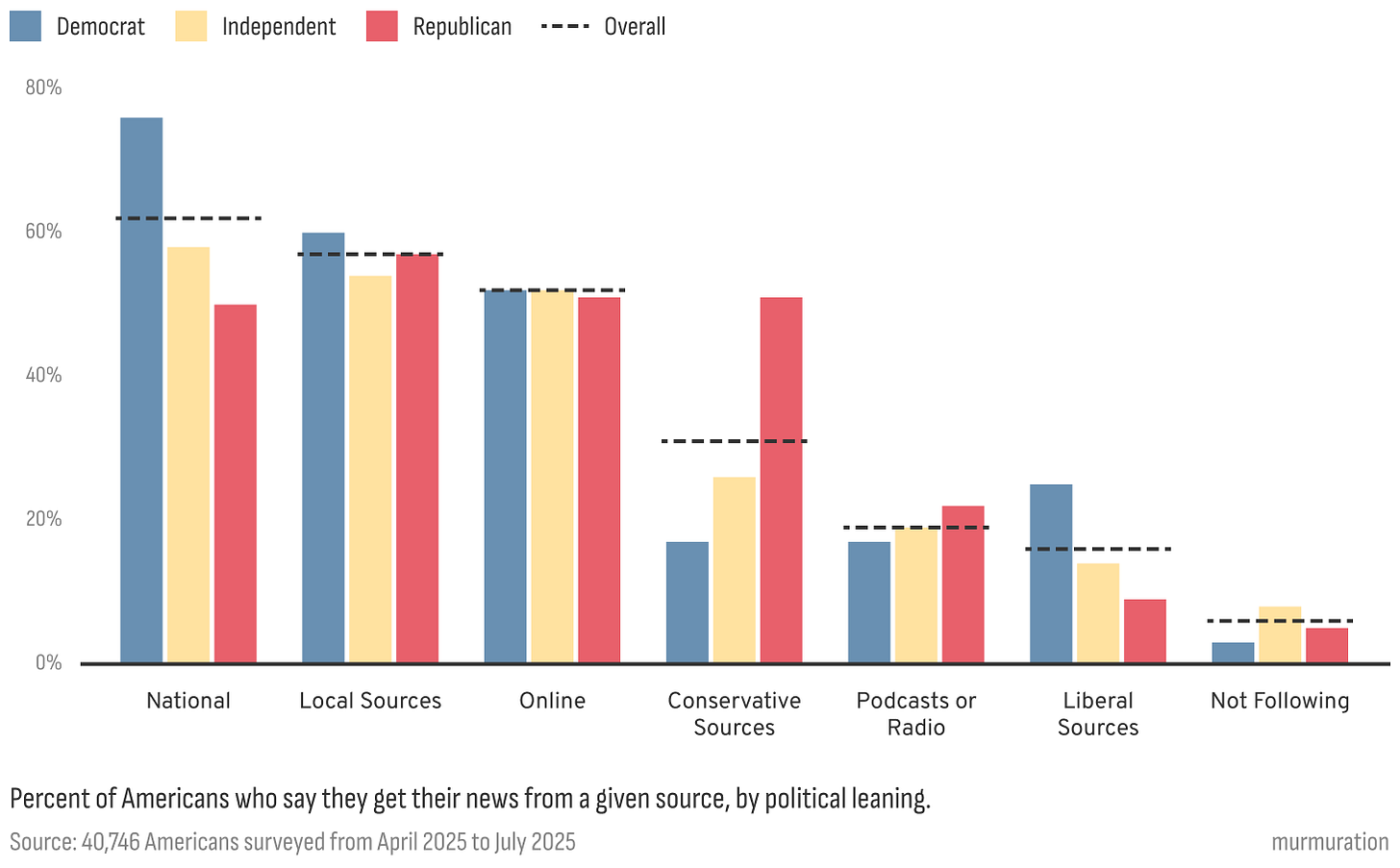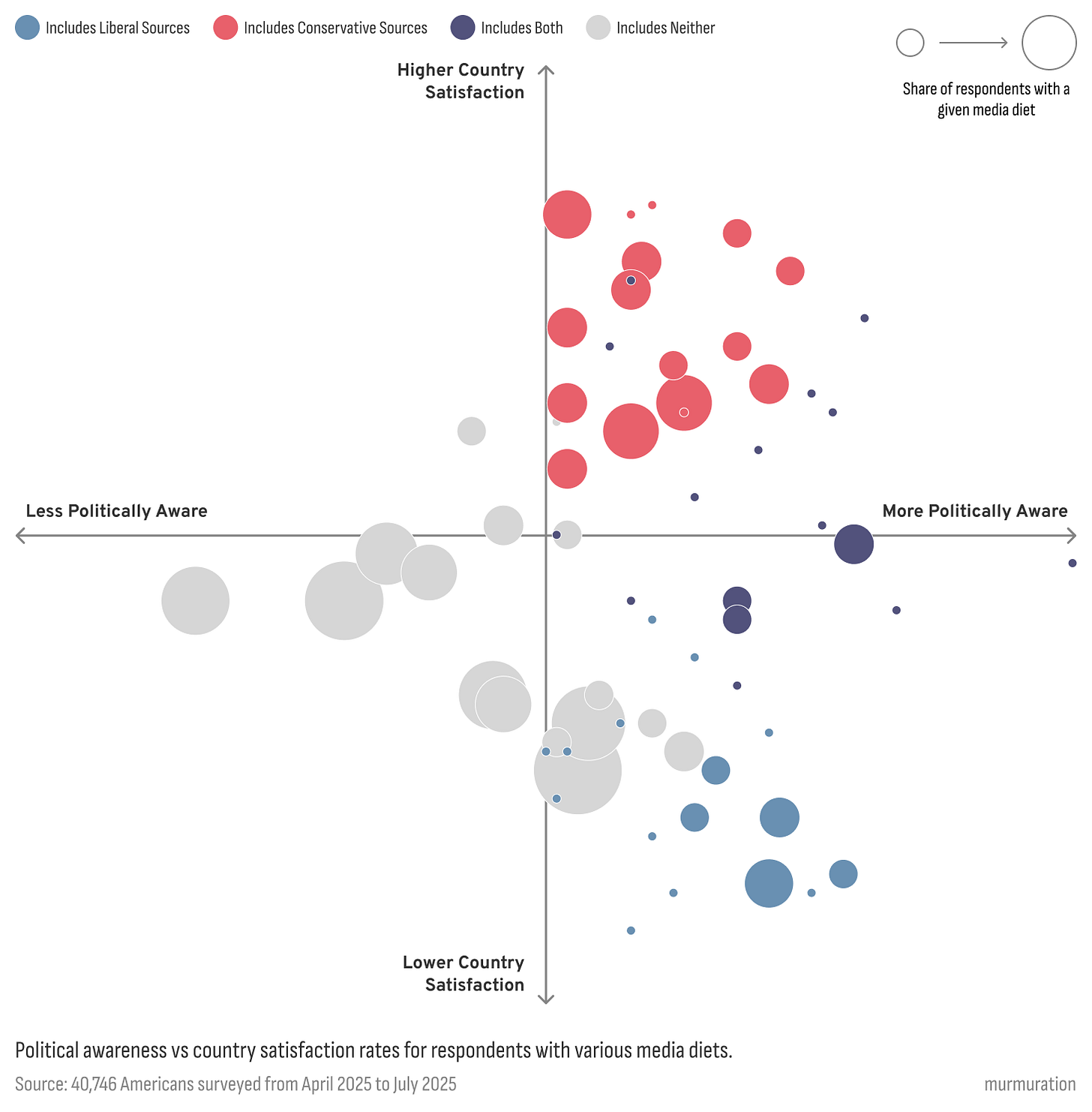Americans today have more choices than ever when it comes to news and political information. Cable networks, podcasts, digital outlets, YouTube shows, and social media influencers are all competing to shape public understanding of what’s happening and why it matters. But news isn’t always something people actively seek out. Often, it’s absorbed passively, while cooking dinner, commuting to work, or scrolling through notifications.
“I listen and watch the news in the morning and throughout my day. I watch Fox news before school and I listen to ABC News on the Alexa while I'm cleaning around the house.” – 31, Female, Republican, Marquette, MI
Others described hearing news from alerts on their phones, professional circles, or word of mouth.
“News alerts on my phone and from friends and family. I also often learn of updates from the work that I do and my professional spaces.” – 27, Female, Democrat, District of Columbia, DC
In this landscape, what people take in—whether deliberately or ambiently—shapes more than just what they know. It shapes how they feel about the country, about politics, and about themselves.
The Media Landscape
Most Americans still rely on traditional sources like national broadcasts and local stations, but they’re no longer the only players in the mix. Podcasts, TikTok, YouTube, Substack newsletters, and AI-powered tools like ChatGPT are becoming part of the media diet.
“My go to sources would be Google, ChatGPT, and TikTok.” – 59, Male, Independent, Harris, TX
Today, 38% of Americans say they use four or more different types of news sources. Among Democrats, that number climbs to 43%, compared to 35% for both Republicans and Independents.
This variation isn’t just about information access. It’s also about how people build political understanding. For some, news consumption is curated and intentional. For others, it’s more sporadic or absent altogether. And for many, ideological alignment plays a defining role.
Political Filter Bubbles
Filter bubbles aren’t just theoretical, they're deeply woven into how Americans engage with the news, shaping what information we see and reinforcing existing beliefs by limiting exposure to differing perspectives.
According to Murmuration’s Civic Pulse data, 41% of Americans get at least some of their political information from partisan sources like Fox News or MSNBC. But conservative outlets are nearly twice as common: 31% of respondents report using right-leaning sources, compared to just 16% for liberal ones.
Democrats are more likely to cross ideological lines than Republicans. While 17% of Democrats say they consume conservative news, only 9% of Republicans report watching or reading liberal sources. Some Democrats describe this as a deliberate effort to seek out balance:
“Comparing biased sources against each other. Read and watch both CNN and FOX and make my own opinions from there.” — 22, Male, Democrat, Contra Costa, CA
“I try to keep them mutual so I will read CNN and Fox News to see the difference.” — 48, Male, Democrat, Franklin, OH
Still, no matter the reason, ideological news has a powerful effect. Those who consume conservative sources tend to feel more satisfied with the direction of the country. Those in liberal-leaning bubbles report feeling worse. Meanwhile, people who engage with both liberal and conservative media, generally fall somewhere in between.
Perhaps most fascinating is this: the more ideologically aligned the media environment, the more confident people tend to be in their political awareness. Those who regularly consume partisan news—left or right—are significantly more likely to say they feel highly informed about social or political issues. This is true even if they consume fewer source types overall.
This creates what could be called the certainty paradox: ideological news reinforces beliefs and boosts confidence, but may offer a narrower, more filtered version of reality. It replaces complexity with clarity and nuance with certainty. That can be emotionally satisfying but it can also fuel polarization.
The Power of Local News
In a fractured media environment where partisan news often drives division, local news stands out as a rare unifying force.
Roughly 57% of Americans get at least some of their news from local sources. This is the highest percentage of any category we asked about. Importantly, the partisan gap here is minimal: 60% of Democrats and 57% of Republicans consume local news. Only family and friends and online (including social media) rank closer in cross-party similarity.
But that still leaves a substantial portion of the country—roughly 4 in 10 Americans—who do not have access to local news or are tuning it out. And the data suggests that they may be missing more than headlines.
People who consume local news aren’t just more informed about their neighborhoods. They also feel better about where they live and act on that feeling. Compared to those who don’t follow local news, they report: higher levels of community wellbeing (+6pp) and a greater sense of belonging (+7pp). They’re also more likely to think their local government is effective (+6pp) and to vote in all local elections, by a striking 17%.
Final Thoughts
At a time when partisan media drives division and reinforces tribal certainty, local news may offer a rare path forward. It reaches across party lines. It builds trust and belonging. And it connects people to the decisions and debates that shape their daily lives.
But local news is also fragile. In many communities, it’s underfunded or vanishing altogether. And if it disappears, we lose not just a news source but a civic anchor.
So as we reflect on these findings, we’re left with a few questions:
Can local news be scaled, supported, and reimagined to meet the moment?
What would it take to rebuild trusted local media ecosystems in communities that have lost them?
And how do we help people recognize the limits of ideological media, not by shaming their choices, but by expanding what they’re exposed to?
If polarization is shaped by what people believe—and how they come to believe it—then understanding their media environment is not just important. It’s essential.
Less clickbait, more community.
Murmuration is a non-profit that strengthens community-driven change at the local level. By equipping local organizations with powerful data, technology, and insights, Murmuration helps them amplify community voices, build collective power, and drive solutions that reflect the lived realities of the people they serve. murmuration.org





